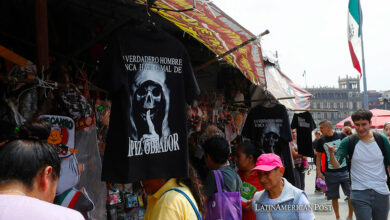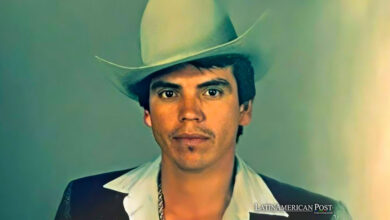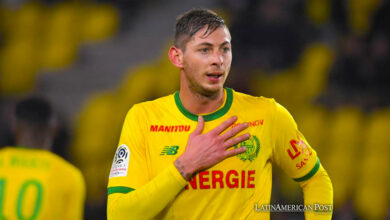Coverage: The hard road of the Olympic cycle. What is it and how does it work?
The Pan American Games of 2019 and the Olympic Games of 2020 are not far away. LatinAmerican Post details how a committee in charge in that period of time works
An Olympic cycle begins just after the completion of the Olympic Games and ends with the next edition of the aforementioned event. During this period, four years have elapsed, and the Bolivarian Games (the year after the Olympics), South American and Central American Games (two years later) and the Pan-American Games ( in the case of Latin America) are held chronologically. three years later).
Leer en español: Reportaje: El duro camino del ciclo Olímpico ¿Qué es y cómo funciona?
According to Peru.com, the Olympic cycle is a reference of planning and training for coaches and leaders with respect to their athletes, who, in turn, have as main objective to participate in the Olympic Games. The technicians plan based on the cycle, but it should be noted that the athletes themselves must ensure their presence in sporting events thanks to the different qualification and preparation tournaments.
Many call Olympics Olympics, but it is a wrong tradition because the Olympiad refers to the lapse of four years between each edition of the games, including all events. There are some rankings for sports that provide Olympic venues, such as those of the ATP / WTA (Tennis); the FIG (Golf), and the UCI (Cycling), added to the minimum marks that have different federations, as RCN.com explains.
For the next edition of Tokyo 2020, number XXXII of the story, some disciplines that were not present in Rio 2016 will be inserted, such as baseball, softball, karate, surfing, skateboarding and finally climbing, added the aforementioned Colombian media.
A very close view
Edwin Cabezas, sports director of the Colombian Olympic Committee (COC), in charge of the methodological monitoring of athletes, leagues, federations and medical staff, spoke exclusively with the Latin American Post about aspects of the topic. Among them the process of prioritization of athletes, the number of athletes who attend each appointment, the power of each Olympic Committee to work on the basis of the raw material and without special assignments by the International Olympic Committee (IOC). Further, of which are the medal candidates athletes with whom it counts, -in this case Colombia-, for the maximum date to be held within a couple of years in Tokyo 2020.
The leader said, "our job is to establish the prioritization strategy that applies to coaches and athletes, as well as to the scenarios, which covers all topics of high sports performance because resources are limited and more in a society where there are increasingly more athletes, and, therefore, more sports practice ".
Cabezas did not hide his satisfaction with what has been achieved so far in the Olympic cycle in which Colombia has already prevailed in both Bolivarianos (Santa Marta 2017) and South American (Cochabamba 2018). In addition, he made his best historical performance in the Central American Games (Barranquilla 2018).
Cabezas added: "In the Pan American we want to be above the 280 athletes, which were the ones we had in the last edition (In Toronto 2015) and in regard to the Tokyo 2020 Olympic Games, the goal is to exceed the 147 participants with which we went to the previous edition (Rio de Janeiro 2016) ".
Priority process
Cabezas explained what the process of prioritizing athletes consists of, and how it applies in the case of Colombia. "The first thing to say is that the range of all these games is not the same. As the demand for games grows, the number of athletes is lower. In the Bolivarians, the range is very broad because there is not even a qualifying phase to participate in them."
The Bolivarians act as an invitation, but the South Americans and Central Americans do give quotas for the most important events such as Pan-American and Olympic Games.
In the specific case of Colombia, its share of athletes for the recent events that make up the Olympic cycle were 900 for the Bolivarians, 582 for the South Americans, and 622 for the Central Americans (hosting this event allowed them to increase the quota of participation in relation to the South Americans, but traditionally they are less). While the goal for the Pan American Games in Lima 2019 is to exceed 300 representatives and as already said, raise the delegation to 147 for the Tokyo Olympics.
The support of the Committee with these athletes obviously depends to a great extent, and in the opinion of Cabezas, on the performance of the athlete. "It works like a funnel. As of the second post-Olympic year, we began to evaluate the performance of the athletes and those who stand out in that second and third year are the ones that have the highest priority for the Committee in the face of the Olympic Games, that is, the support goes for those who have had better performance," he said.
What are the priority athletes?
When asked if swimmer Isabella Arcila is a credit card for Tokyo, after her brilliant performance in the Central Americans of Barranquilla (7 medals, including 4 gold), Cabezas was emphatic. "It's a good question that you do, since at first glance you can see that if she is a candidate for medals in the Olympics but the truth is that she is not a potential candidate for a medal even in the Pan-American Games, since the level in that discipline in these next games is already far superior. For her to classify both appointments, it is within the positive parameters."
The Colombian athletes, called by their committee as "Tokyo 2020 Athletes", are those who, if they fall IGNORE INTO the range of competing for Olympic medal or in the worst case, to finalize great performances in their disciplines in the maximum event. In judo Yuri Alvear, in fencing Saskia Van Erven, in fight Andrea Olaya and Carolina Castillo, while Yuberjen Martínez, Ceiber Ávila, Jorge Luis Vivas and Deivis Julio Blanco in boxing, Oscar Figueroa, Francisco Mosquera, Mercedes Pérez and Ana Segura in the lifting weights, as well as Muriel Coneo and Catherine Ibarguen in athletics.
The list continues with Esteban Soto in March, Bernardo Valoyes in 200 meters, Martha Bayona and Fabián Puerta in track cycling, plus Fernando Gaviria, Nairo Quintana, Sergio Luis Henao, Esteban Chaves, Jarlinson Pantano, Miguel Ángel López, and Rigoberto Urán in traditional cycling. He also mentioned Mariana Pajón, Felipe Ruíz and Carlos Mario Oquendo in BMX, as well as the duo of Juan Sebastián Cabal and Robert Farah in tennis.
Growth in South America
Cabezas clarified that the International Olympic Committee (IOC) does not impose any plan or strategy for the different committees distributed in each country because each nation establishes them based on their needs and sports strengths, population, or other conditions. "The objective of Colombia is to position itself as a South American power," he said.
The results of the most recent games place Colombia, as an example to follow in this region of the world. In fact, Cabezas proudly points out his compatriots who work in committees in other countries such as Chile and Ecuador, nations that are gradually growing in their production of medals. Among these coffee specialists are among others Diego Toro, Eduardo Gonzalez, Albeiro Quiroz, Carlos Iván Dermeo and Dr. Juan Carlos Quinceno. "There is a Colombian seed that expands to other countries, especially in the organizational part and sports methodology, although the Cuban school has always been a model to follow," he said.
The leader assured that the achievements of Colombia in recent years have even more value if one takes IGNORE INTO account that the policy of the South American country regarding the granting of athletic scholarships for athletes is not the most frequent nor priority.
Examples to follow in the world
In LatinAmerican Post we had the theory that a country with a large population, examples Brazil and Mexico, would have some advantages to select their sporting talents for competitions. In this regard, Cabezas said "the amount is not necessarily an advantage if things are not done well or if there is no defined sports policy. Look at the example of Armenia, a small nation formerly belonging to the Soviet Union that has achieved important achievements in combat sports."
This example can perfectly be aligned with others such as Ethiopia and Kenya (in track and field) and Jamaica (speed athletics), small countries that invest in the discipline in which they produce more and better athletes, which is reflected in a good historical number of medals.
This is how an Olympic cycle, in the case of Latin America, is made up of five events distributed over four years, which gradually cleanse the quality of the athletes who attend, since sporting countries that are much more powerful participate in each event. Each country invests and prioritizes the athlete that generates the best results in the previous games and in other qualifying events, and based on that they make their predictions.
Those who participate?
Remember that in the Bolivarians only six countries intervene: Venezuela, Colombia, Panama, Ecuador, Peru, and Bolivia. Meanwhile, in the South American countries, the 10 most countries are Guyana, Suriname, Netherlands Antilles, Aruba, and Panama, reported Cochabamba2018.bo.
The Central Americans already include 38 countries, but only Colombia and Venezuela participate in South America. There are not two strong ones like Brazil and Argentina, but then, if Cuba and Mexico participate, they are the main dominators of this event, as reflected by Barranquilla2018.com.
In the Pan-American Games, the level of demand has risen considerably since the United States (winner of 15 of the 17 editions) and Canada (third in the historic medal count), become part of them. In addition, Cuba, Mexico, Brazil, and Argentina intervene. In the most recent edition of Toronto 2015, 41 nations attended, according to the official page of this event. The ten South American countries participate.
Finally, the Olympics are at the highest level. According to Olympic.Org, more than 200 countries participated in the Rio 2016 edition. For South Americans, it is no longer just a matter of facing the United States, Cuba, Canada, and Mexico, but also with the United Kingdom (consisting of England, Scotland, Ireland and Wales), China, Germany, Russia, Italy, and France.
List of international events belonging to the Olympic cycle ( According to Elmundoolimpico.blogspot.com) :
2017:
European Festival of the European Summer Youth
European Youth Olympic Festival
Games of the Small States of Europe – San Marino, San Marino
World Games – Wroclaw, Poland
Bolivarian Games Santa Marta 2017 – November 11 and 25, 2017
2018:
PyeongChang Winter Olympic Games 2018 – From 9 to 25 February
Paralympic Winter Games PyeongChang 2018 – From March 9 to 18
Games of the Commonwealth Gold Coast 2018 – Of the 4 to the 15 of April of 2018
South American Games Cochabamba 2018 – From May 26 to June 08
Central American and Caribbean Games Barranquilla 2018 – From July 19 to August 3.
Asian Summer Games Indonesia 2018 – From August 18 to September 2, 2018.
Olympic Summer Youth Games – From October 6 to 18
2019:
Pan American Games Lima 2019 – From July 26 to August 11
Parapan Am Games Lima 2019 – From August 21 to September 1
Pan-African Games (For programming)
Pacific Games Apia 2018, in Samoa – From August 17 to 30
Olympic Festival of the European Summer Youth Baku 2019
European Youth Winter Festival Sarajevo 2019
Minks European Games 2018 – From Friday June 14 to June 30
2020:
Olympic Winter Games Lausanne 2020 – From January 10 to 19.
LatinAmerican Post | Onofre Zambrano
Translated From 'Reportaje: El duro camino del ciclo Olímpico ¿Qué es y cómo funciona?'





